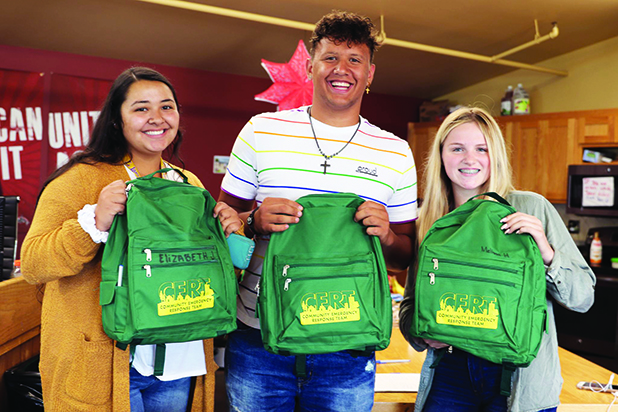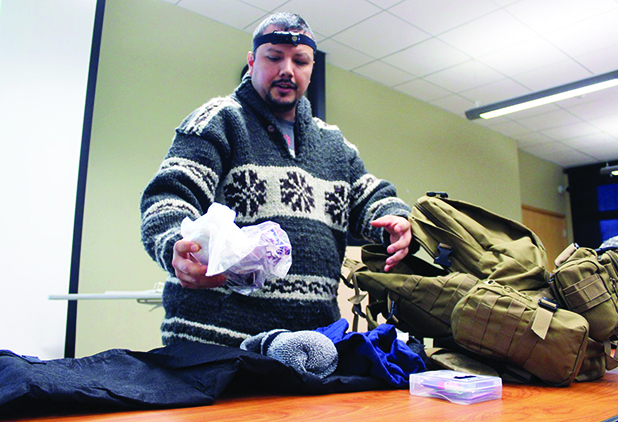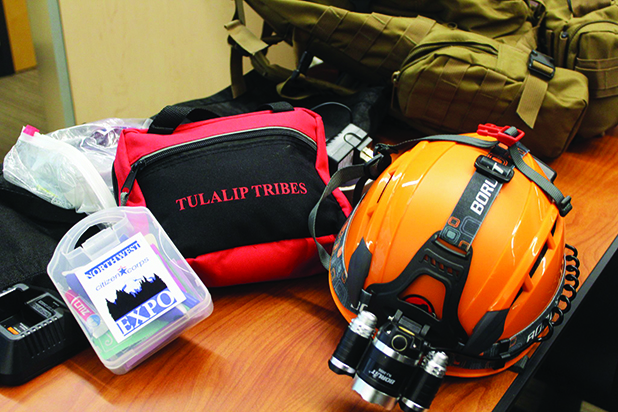
By Kalvin Valdillez, Tulalip News
“When building a bug out or a go bag, it’s important to get enough supplies and essentials to get you from point A to point B. Point A is the threat of danger and point B is the location that you choose for safety,” said Angel Cortez, Tulalip Emergency Management Director.
The Bolt Creek fire caused a lot of panic and distress for many families on the westside of Washington State. The air quality index at Tulalip reached an alarming 165 during the height of the fire, and people who lived in the nearby vicinity of the wildfire were urged to leave immediately. As many of our readers may know, Sky Valley Fire sent out an evacuation notice via a text message alert on the afternoon of September 10.
Meant for people in the Skykomish region, the alert was accidently sent out to everybody in Snohomish County. Residents of Tulalip, Everett, and Marysville took to social media to get the real scoop, asking their friends, families and local first responders if they needed to pack up and evacuate as the warning advised. And faced with a problem that us western Washingtonians hardly ever have to consider, a lot of people pondered what to grab in that emergency situation.
“It’s good to have a plan that meets the needs of you and the people you care about,” Angel said. “I tell people that preparing for something is basically how comfortable that you want to be in an uncomfortable situation. When people think about creating or building their bug out bag, they’re building them to provide safety, to provide comfort, and to provide the essentials for sustaining you to get to the next destination or a place of safety.”

Go bags, also known as bug out bags or 72-hour safety kits, are personalized backpacks that contain everything you need in the case of an emergency where you need to evacuate your home at a moment’s notice. Prior to COVID, the Tulalip Tribes Emergency Management team regularly held annual CERT (Community Emergency Response Team) classes for both youth and adults. Among all the fun and important teachings that the CERT trainings offer, including how to triage and help others during a natural disaster, part of the classes are dedicated to teaching people how to build their own go bags.
Said Angel, “We think of the big disasters as earthquakes, tsunamis, flooding, and fires. But here at Tulalip, for the people who live on the cliffs or on the beaches, what about erosion? What happens if the cliff gives way? You might need to leave for that immediately. What if it’s in the middle of the night and you need to just get up, get your clothes on, your shoes on and leave. That’s where the bug out bag comes into play. It’s not being paranoid, it’s good to think of those things beforehand, rather than in the moment during an emergency situation.”
When creating your own bug out bag, Angel recommends personalizing it to your individual needs and stocking it with items you will actually use while in distress, such as tasty snacks that you enjoy as opposed to dry foods that may go to waste. He also advises that each member of your family creates their very own go bag, and to pack comfort items for the kids like stuffed animals, their favorite toys, and their choice of entertainment including tablets and books.
He said, “I have five kids. So, if something were to happen, each of my kids can grab their own bag, and my wife and I can grab our bags. In my bag, I might have different things than my wife does. But put together, we have everything we need. And then with the kids, it’s about comfort. Maybe it’s their favorite stuffed animal, maybe it’s a small bag of candy, just something to keep them occupied because they’ll be scared and worried about all the crazy stuff that’s happening around them. It kind of de-escalates the situation in their mind and allows them to have some kind of comfort. So, if something happens in the middle of the night, it’s easier for everybody to grab their bags, get in the car, and go.”

Angel offered a few tips that will guide you when assembling your own go bag. First and foremost, he urges everybody to update their bags regularly throughout the seasons, noting that an abundance of warm winter gear will occupy space and weigh you down during the spring and summer seasons. Next, he states that it would be extremely beneficial to learn all the proper techniques of the equipment that you pack. He believes this is especially true if you have young children because it presents the opportunity to learn as a family, and the kids are better prepared if disaster does strike.
If you are wondering where to begin, Angel said a good place to start is the hunting and camping section of your favorite retail store such as Walmart or Target. In those isles, you are sure to find a number of multi-use items that can be stored in your go bag like paracord, multi-tools, tarps, and flashlights. And as far as the essentials that every bug out bag should have, he encourages everybody to follow the five Cs of survival – cutting tools, combustion devices, cover and shelter, containers, and cordage.
“Dave Canterbury came up this concept and he’s kind of an outdoors guy,” he explained. “He’s famous in the prepper community. These five things are the basics to help you in any situation. Your cutting tool is your knife, or it could be a multi tool. Combustion is a way to create fire, you never know if you need to start fire. Combustion is big because maybe you need to clean your water, and heat it up, and that’s where your container comes in. Usually, it’s a metal container with a handle or something that you can cook out of, you can boil water, of you can drink out of it. You want all your equipment to be multi-use and your container has to do that as well.”
He continued, “And then you have your cover, maybe it’s a tarp to get you out of the rain, or maybe it’s a lightweight sleeping bag or blanket. It’s whatever to keep you covered from the elements. In the summer, maybe it’s just to provide shade to keep you from getting sunburned. The other one is cordage, having some kind of paracord, preferably 550 paracord. And 550 means how much weight that cord can handle. Parachute cord and is very thin, very strong, very durable, and it’s lightweight, so you can carry a lot of length in your cord where it doesn’t take up a lot of room in your bag. There’s a lot of uses for cordage, whether you’re tying down your tarp for shelter, or maybe you forgot to bring a belt and your pants are falling down, you know, it’s good for whatever your rope or cordage can do for you.”
Angel went on to explain that Canterbury also curated an extended list of essentials, going from the five Cs to ten Cs of survival. That list includes candling, or flashlights and headlamps, cotton for washing, keeping cool and filtering large sediment out of your water, cargo tape, a.k.a. duct tape or gorilla tape, a compass, and a canvas needle for repairing torn items and assisting with paracord.
In addition to the ten Cs of survival, Angel also advises people to pack a first aid kit, and any medication you may need such as an epi-pen, insulin, or an albuterol inhaler, as well as batteries and chargers. Another tip is shopping the sales of grocery stores during your normal shopping outings and purchasing extra food here and there to store away in case of an emergency. He also believes that keeping your gas tank at least half-full will be extremely helpful in the event you need to get in your car and get as far away from the disaster as possible. If you have pets, it’s imperative that they each have their own bug out bags as well, and be sure to pack it with food, water, snacks, blankets, medication, and toys specifically for them.
And finally, he encourages everyone to sit down and map out a plan with your loved ones in case a disaster were to occur. Within that plan you should also assign a third party contact in case cell service is unavailable or disrupted, establish a safe place to meet up in case your party is split up. You should also have additional bags at the ready, such as an Inch Bag for long-term emergencies or a Get Home Bag that is stored in your car and is filled with all the essentials to get you back home in the event of a catastrophic disaster.
“Our ancestors were preppers,” expressed Angel. “They were always prepping for winter. They went out and caught fish, gathered food, and hunted during summer harvest and put it away for the winter. They created medicines and winter clothing. Our ancestors knew this was important. They knew what it was going to take to take care of their people. They were always thinking ahead about the future, and how to provide for the babies and for their families. We have to think that way too. My goal for the community is I want people to start thinking about it, talking about it, researching it, and doing it now. Because if you wait until game day to do it, you’re already way too late.”